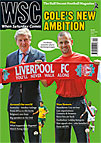 Sasha Goryunov looks at how attempts to improve youth development don't always have the desired effect
Sasha Goryunov looks at how attempts to improve youth development don't always have the desired effect
What attracted Zenit St Petersburg, runaway leaders of the Russian league, to Aleksandr Bukharov? It wasn’t his knee – which has a history of cruciate damage. It may have been his 16 goals in 23 games in 2009 for reigning champions Rubin. But those goals would have been insufficient without something else – Bukharov’s Russian passport.
Bukharov’s transfer to Zenit is the latest product of the 6+5 rule, which seeks to give homegrown players a boost. The rule has a familiar back story – allegations that foreign players are crowding out local talent and hence harming the national side. Russian football saw an influx of cheap and unremarkable foreigners in the 1990s, and the trend only accelerated as money flowed into the game.
National frustrations simmered in 2005. CSKA won the UEFA Cup with only six Russian starters while Russia struggled to qualify for the World Cup (losing 7-1 in Lisbon). Then, Alexey Fedorychev spent tens of millions bringing ten Portuguese players to Dynamo Moscow. In August Dynamo fielded a fully-foreign XI against FC Moscow and, typically, lost. They finished in mid-table. It was the nadir of the buy-from-abroad approach.
A quota system was meant to be the solution. Any player not holding a Russian passport would be classified as a “legioner”. A team could field seven legioners at once in 2006, decreasing to five by 2010. A National Football Academy (NFA) fund, financed by charity-loving Roman Abramovich, was also established. In 2008 the reserves’ championship was replaced with a youth tournament, with each team having to play seven Russians under the age of 21. On the face of it, things have improved. Russia’s Under-17s, coached by Igor Kolyvanov, were European champions in 2006. Two years later the full national side produced its best tournament performance in reaching the Euro 2008 semi-finals. Zenit won the 2008 UEFA Cup with seven homegrown players (three came from their youth system). Last year’s champions Rubin relied heavily on legioners after promotion in 2002 but now have 16 Russians in the squad.
But this was actually due to the quota. Not really. Most of the heroes of Euro 2008 were regulars before 2006 while Kolyvanov’s boys have achieved little since their European victory. In fact, evidence suggests that the limit has proved massively demotivating for younger players. Wanted from a relatively early age, they can command high wages. Then they are usually guaranteed a place in the team and, if benched, they can wave their passport at their employers and threaten to go elsewhere, as the teenage midfielder Vladislav Ryzhkov did at Spartak Moscow – he was sent on loan to First Division Shinnik.
Smaller clubs can no longer afford good Russian players but they are not rushing to invest in their academies. Nine of the 16 top-flight clubs are funded by their regions’ governments who can be understandably reluctant to spend part of their budget on youth development. An incoming official might not want to invest in football, as Tom Tomsk found out last season – Vladimir Putin’s intervention kept the club going.
In these conditions a Russian player can keep his place in a top team despite being, well, rubbish. Just look at Spartak’s Soslan Dzhanaev, who dropped a series of crosses into his own net last season. (Dzhanaev’s replacement, Sergey Pesyakov, fared no better in his first game.) In the meantime, the club are trying and failing to sell the Croat Stipe Pletikosa.
A great irony of the limit is that the best young player to emerge since its introduction – the CSKA Moscow midfielder Alan Dzagoev – did not come from a Premier League’s club youth system but from the Konoplev Football Academy, one of three such organisations being funded through the NFA. The academies were not supposed to do all the work, yet the clubs are instead looking for ways to turn their foreigners into Russians as the high-profile cases of Welliton and Oleksandr Aliev demonstrate. The former only arrived in Russia from Brazil in 2007, while the latter was born in Khabarovsk near the Chinese border and is classified as a Russian in the squad list, yet he is a full Ukraine international and Ukrainians are only allowed one citizenship.
The latest word on the matter came from Sergey Fursenko, the head of the Russian Football Union. He announced that the rules defining a legioner should be made more sophisticated “in order to utilise the territory of the CIS to a greater extent. A young player from the CIS should not be affected by the limit as he is a potential footballer for the Russian national team.” To paraphrase, the original plan has failed so let’s bend (our own) rules. How very Russian, alas.
From WSC 283 September 2010